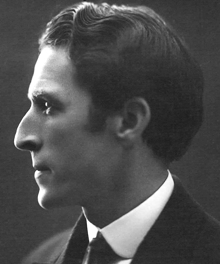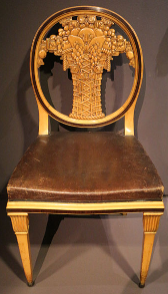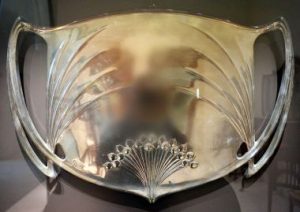French Designer Paul Follot was a leader of the Art Deco movement. Most notably, he took a role as head of the Pomone decorative art workshop of Le Bon Marché department store.

Image source: https://en.wikipedia.org/wiki/Paul_Follot#/media/File:Paul_Follot_in_1927,_by_Boivi.jpg
His Life
Paul Follot was born in Paris in 1877, to a wallpaper manufacturer Fèlix Follot. Fallot, trained as a sculptor under artist Eugène Grasset, his first designs were by inspired by Neo-Gothic art. Between 1901 and 1903, he approached Art Nouveau, creating silver objects, fabrics, bronzes and jewels for the showroom “La Maison Moderne.” At the same time, he joined “L’Art dans Tout,” a group of artists that promoted French craftsmanship. . As a founding member, he meet decorative artist Maurice Dufrêne, who heavily influencing his style.
Beginning with 1904, Follot worked as an independent designer. Then, by 1910 he headed his own decorating company, catering to a wealthy clientele. They developed his reputation for quality and elegance, with a classical taste deeply intertwined with Deco sensibilities. Among his products, there were luxury furniture, textiles for Cornille et Cie, carpets for Savonnerie, silver for Orfèvrerie Christofle and china designs for the Wedgwood company of England, as well as wholly new designs of jewelry developed throughout the decade. Further, by 1923, Follot took charge of the Pomone decorative art workshop of Le Bon Marché department store. Such a place was characterized by affordable, high quality furniture and decorations. There, he redesigned the company symbol as well, a tree laden with fruit – one of many nature-patterned symbols typical of Deco.
His leadership bore immediate fruit, as his design for the Pomone Pavilion, at the 1925 International Exposition of Modern Industrial and Decorative Arts, was a resounding success. However, by 1928, his position changed, as he joined the Parisian branch of Waring&Willow, an English furniture company, as director. There, together with Serge Chermayeff, he introduced motifs of fruit, garlands and cornucopias to the company’s image.
By 1931, he resumed independent practice, and kept working until his death, in 1941.

Image source:https://search.creativecommons.org/photos/80d507c8-1dcd-47f7-8486-fbca6f01630d by dalbera
Follot’s Work
Silver tea and coffee service
Representing a rare and important French Art Nouveau, the silver coffee and tea service by Paul Follot, includes a tray, a tea and a coffee pot, as well as containers for sugar and cream. Characteristically decorated with whiplash curves, folds similar to fabrics and splashes of leaves, it currently resides in the Musee d’Orsay, the Victoria & Albert Museum, and the Brohan Museum, ca 1902. In the year 2000, an identical set was exhibited during the Art Nouveau 1890-1914 exhibit, at the Victoria & Albert Museum and the National Gallery of Art, ca 1904.

Image source:https://commons.wikimedia.org/wiki/File:Paul_follot,_servito_da_t%C3%A8_e_caff%C3%A8,_1900-05_ca.jpg
Art Deco Chair
Paul Follot was one of the top Art Deco designers, combining traditional forms with rich decorations. This gilt bergère was created by the iconic designer during the second quarter 20th century, blending a softly curved frame with a soft cotton/linen blend. The wooden shapes are accented with gilt over a red underlay, which gives the finish its distinctively gorgeous depth.

Image source: https://commons.wikimedia.org/wiki/File:Paul_follot,_coppia_di_sedie_da_sala_da_pranzo,_francia,_post_1912,_01.JPG
The Deco Style
Follot’s early designs reflect the Gothic revival and its foliated motifs. Follot acquired a taste for wooden patterns, toghether wirh Grasset’s sculptures. He made well-upholstered pieces in delicately curved, with ornate gilded wooden frames, and liked to use rare materials, with inlays of contrasting colors or gilded bronze friezes. His furniture therefore approached the styles of Louis XVI or the Empire rather than the contemporary Art Nouveau.

Image source: https://en.wikipedia.org/wiki/Paul_Follot
After 1910, Follot’s designs were quieter and followed classic guidelines as he evolved towards the Art Deco. For example, the set of dining rooms of Follot in sycamore, ebony and amarato, exhibited at the Salon d’Automne in 1912, is one of the first examples of Art Deco. Additionally, Follot was a “purist” art deco, and saw his work as the refinement of classic French design, often designing fabrics and wallpapers in traditional and modern styles. In 1928, Follet said,”we know that the necessary alone is not enough for the man and that the superfluous is indispensable for him, otherwise we also suppress the music, the flowers, the perfumes … and the smile of the ladies!”
Info sources:
https://en.wikipedia.org/wiki/Paul_Follot
